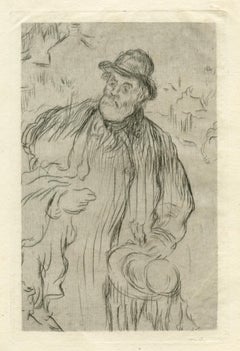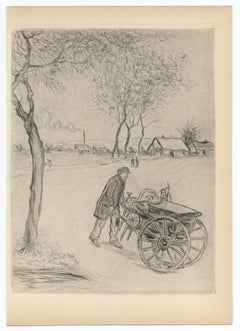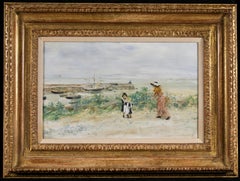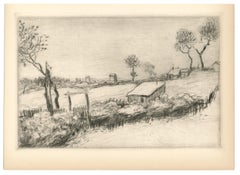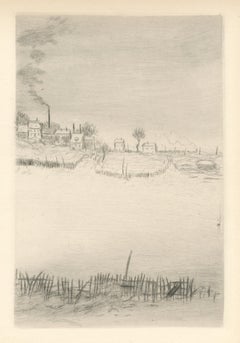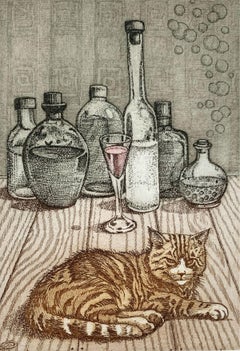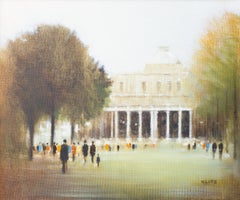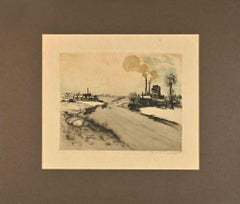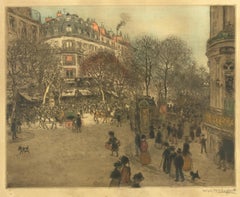Jean-Francois Raffaelli Art
to
11
1
Overall Width
to
Overall Height
to
5
8
6
2
3
1
1
7
5
6
4
3
2
2
1
1
1
1
1
1
1
1
1
1
1
1
1
1
1
9
3
3
2
2
13
9,081
2,810
2,504
1,348
3
3
7
6
Artist: Jean-Francois Raffaelli
"Le Marchand de Habits" original etching
By Jean-Francois Raffaelli
Located in Henderson, NV
Medium: original etching and drypoint. Executed in 1895; catalogue reference Delteil 24. This impression on laid paper was printed in 1895 for Gustave Geffroy's "La Vie Artistique". ...
Category
1890s Jean-Francois Raffaelli Art
Materials
Etching
"Le Remouleur" original etching
By Jean-Francois Raffaelli
Located in Henderson, NV
Medium: original etching and drypoint. Catalogue reference: Delteil 76. Printed in 1909 and published in Paris by H. Floury. Plate size: 8 3/8 x 6 1/2 inches (212 x 165 mm). Not sign...
Category
Early 1900s Jean-Francois Raffaelli Art
Materials
Etching
Mother & Children - Impressionist Figurative Oil by Jean-Francois Raffaelli
By Jean-Francois Raffaelli
Located in Marlow, Buckinghamshire
Signed oil on canvas figures in landscape by French impressionist painter Jean-Francois Raffaelli. The work depicts two young girls with their mother in a landscape overlooking boats...
Category
Early 1900s Impressionist Jean-Francois Raffaelli Art
Materials
Oil, Canvas
"Sous la pluie" original etching
By Jean-Francois Raffaelli
Located in Henderson, NV
Medium: original etching and drypoint. Catalogue reference: Delteil 86. This lovely drypoint was executed by Raffaelli in 1909 and published in Paris by H. Floury. Plate size: 3 1/4 ...
Category
Early 1900s Jean-Francois Raffaelli Art
Materials
Etching
"La Neige (soleil couchant)" original etching
By Jean-Francois Raffaelli
Located in Henderson, NV
Medium: original etching and drypoint. Catalogue reference: Delteil 86. This impression on wove paper was printed in 1909 and published in Paris by Henri Floury. Plate size: 5 3/4 x ...
Category
Early 1900s Jean-Francois Raffaelli Art
Materials
Etching
"La Neige (soleil couchant)" original etching
By Jean-Francois Raffaelli
Located in Henderson, NV
Medium: original etching and drypoint. Printed in 1909 and published in Paris by Henri Floury. Plate size: 8 1/4 x 5 5/8 inches (212 x 143 mm). Not signed.
Category
Early 1900s Jean-Francois Raffaelli Art
Materials
Etching
Deux vieillards aux chatons - Impressionist Figurative Oil by J F Raffaelli
By Jean-Francois Raffaelli
Located in Marlow, Buckinghamshire
Signed figures in interior oil on panel by French impressionist painter Jean-Francois Raffaelli. The piece depicts two old men seated in an interior. One is reading his paper as the other naps and there are several kittens on the floor. Painted in the artist's distinctive style.
Signature:
Signed lower left
Dimensions:
Framed: 9.5"x8"
Unframed: 5.5"x4"
Provenance:
Brame & Lorenceau have confirmed the authenticity of this work and it will be included in the digital catalogue raisonne of the painter which is under preparation
A certificate of authenticity fromBrame & Lorenceau accompanies this painting
Private collection - United States
Original artists label verso
Jean-François Raffaëlli's father was a failed Italian businessman and Raffaëlli himself was, among other things, a church chorister, actor and theatre singer. He then studied under Gérôme at the École des Beaux-Arts in Paris. He travelled to Italy, Spain and Algeria and on his return to France settled in Asnières.
In 1876, on a trip to Brittany, he first saw the potential of realist subject matter, if treated seriously. He became involved in meetings of artists at the Café Guerbois, where the Impressionist painters used to gather. As a result, Degas, contrary to the advice of the group, introduced Raffaëlli to the Impressionist exhibitions - according to one uncertain source as early as the very first exhibition, at the home of Nadar, and certainly to those of 1880 and 1881.
In 1904, Raffaëlli founded the Society for Original Colour Engraving. He first exhibited at the Salon de Paris in 1870 and continued to exhibit there until he joined the Salon des Artistes Français in 1881, where he earned a commendation in 1885, was made Chevalier of the Légion d'Honneur in 1889 and in the same year was awarded a gold medal at the Exposition Universelle. In 1906 he was made Officier of the Légion d'Honneur. He was also a member of the Société Nationale des Beaux-Arts. In 1884, a private exhibition of his work cemented his reputation.
He contributed to several newspapers such as The Black Cat (Le Chat Noir) in 1885 and The French Mail (Le Courrier Français) in 1886 and 1887. He published a collection entitled Parisian Characters, which captured his favourite themes of the street, the neighbourhood and local people going about their lives. In 1880 he participated, with Forain, on the illustration of Joris Karl Huysmans' Parisian Sketches (Croquis Parisiens). He also illustrated Huysman's Works. As well as working as an illustrator, he also made etchings and coloured dry-points.
His early attempts at painting were genre scenes, but once he was settled in Asnières he started to paint picturesque views of Parisian suburbs. From 1879 onwards, his subject matter drew on the lives of local people. These popular themes, which he treated with humanity and a social conscience, brought him to the attention of the social realist writers of the time such as Émile Zola. In addition to his realist style, Raffaëlli's dark palette, which ran contrary to the Impressionist aesthethic, helped to explain the opposition of those painters to his participation in their exhibitions. More concerned with drawing than colour, he used black and white for most of his paintings. Towards the end of his life, he lightened his palette, but without adopting any other principles of the Impressionist technique.
After painting several portraits, including Edmond de Goncourt and Georges Clémenceau, he returned to genre painting, particularly scenes of bourgeois life. Later in his career, he painted mainly Breton-inspired sailors and views of Venice. His views of the Paris slums and the fortifications, sites which have almost completely disappeared, went some way towards establishing a genre in themselves and perpetuated the memory of the area: The Slums, Rag-and-Bone Man, Vagabond, Sandpit, In St-Denis, Area of Fortifications. His realistic and witty portrayal of typical Parisian townscapes accounts for his enduring appeal.
Born in Paris, he was of Tuscan descent through his paternal grandparents. He showed an interest in music and theatre before becoming a painter in 1870. One of his landscape paintings was accepted for exhibition at the Salon in that same year. In October 1871 he began three months of study under Jean-Léon Gérôme at the École des Beaux-Arts in Paris; he had no other formal training.
Raffaëlli produced primarily costume pictures until 1876, when he began to depict the people of his time—particularly peasants, workers, and ragpickers seen in the suburbs of Paris—in a realistic style. His new work was championed by influential critics such as J.-K. Huysmans, as well as by Edgar Degas.
The ragpicker became for Raffaëlli a symbol of the alienation of the individual in modern society. Art historian Barbara S. Fields has written of Raffaëlli's interest in the positivist philosophy of Hippolyte-Adolphe Taine, which led him to articulate a theory of realism that he christened caractérisme. He hoped to set himself apart from those unthinking, so-called realist artists whose art provided the viewer with only a literal depiction of nature. His careful observation of man in his milieu paralleled the anti-aesthetic, anti-romantic approach of the literary Naturalists, such as Zola and Huysmans.
Degas invited Raffaëlli to participate in the Impressionist exhibitions of 1880 and 1881, an action that bitterly divided the group; not only was Raffaëlli not an Impressionist, but he threatened to dominate the 1880 exhibition with his outsized display of 37 works. Monet, resentful of Degas's insistence on expanding the Impressionist exhibitions by including several realists, chose not to exhibit, complaining, "The little chapel has become a commonplace school which opens its doors to the first dauber to come along."An example of Raffaëlli's work from this period is Les buveurs d'absinthe (1881, in the California Palace of Legion of Honor Art Museum in San Francisco). Originally titled Les déclassés, the painting was widely praised at the 1881 exhibit.
After winning the Légion d'honneur in 1889, Raffaëlli shifted his attention from the suburbs of Paris to city itself, and the street scenes that resulted were well received by the public and the critics. He made a number of sculptures, but these are known today only through photographs.[2] His work was also part of the painting event in the art competition at the 1912 Summer Olympics. In the later years of his life, he concentrated on color printmaking. Raffaëlli died in Paris on February 11, 1924
Museum and Gallery Holdings:
Béziers: Peasants Going to Town
Bordeaux: Bohemians at a Café
Boston: Notre-Dame; Return from the Market
Brussels: Chevet of Notre-Dame; pastel
Bucharest (Muz. National de Arta al României): Market at Antibes; Pied-à-terre
Copenhagen: Fishermen on the Beach
Douai: Return from the Market; Blacksmiths
Liège: Absinthe Drinker...
Category
1890s Impressionist Jean-Francois Raffaelli Art
Materials
Oil, Panel
"La terrain perdu" original etching
By Jean-Francois Raffaelli
Located in Henderson, NV
Medium: original etching and drypoint. Catalogue reference: Delteil 16. Printed in 1909 and published in Paris by Henri Floury. Plate size: 5 1/2 x 7 3/4 inches (142 x 197mm). Not si...
Category
Early 1900s Jean-Francois Raffaelli Art
Materials
Etching
Le Petit Oiseau - Etching by Jean François Raffaelli - 1915
By Jean-Francois Raffaelli
Located in Roma, IT
Hand signed. Not numbered. With dedication to "Bernard" (1921).
Etching and aquatint technique. Perfect conditions.
Image Dimensions : 15 x 19 cm
Passepartout included : 35 x 50 cm
Category
1910s Post-Impressionist Jean-Francois Raffaelli Art
Materials
Etching
Landscape - Etching by J. F. Raffaelli - Late 19th Century
By Jean-Francois Raffaelli
Located in Roma, IT
Etching and drypoint. Hand signed.
Very good condition.
Category
Late 19th Century Modern Jean-Francois Raffaelli Art
Materials
Drypoint, Etching
Programme for the Theatre - Lithograph by J. F. Raffaelli - 1889
By Jean-Francois Raffaelli
Located in Roma, IT
Programme for the Theatre is a Lithograph realized by Jean François Raffaelli (1850-1924).
Good condition on a yellowed paper included a white cardboard passpartout (35x51 cm).
Hand signed by the artist on the lower margin.
Jean-François Raffaëlli (April 20, 1850 – February 11...
Category
Late 19th Century Art Nouveau Jean-Francois Raffaelli Art
Materials
Lithograph
La Fumee du Bateau
By Jean-Francois Raffaelli
Located in New York, NY
Jean-François Raffaëlli (1850-1924), La Fumee du Bateau, color etching and drypoint, 1911, signed and numbered in pencil lower right. Reference: Delteil 98. In very good condition, ...
Category
1910s Realist Jean-Francois Raffaelli Art
Materials
Drypoint, Etching
L'embarquement de boeufs - Impressionist Oil, Cattle by Jean Francois Raffaelli
By Jean-Francois Raffaelli
Located in Marlow, Buckinghamshire
Wonderful signed oil on panel cattle and figures in landscape by French impressionist painter Jean-Francois Raffaelli. The work depicts oxen being loaded onto ships in Honfleur, France en route to England.
Signature:
Signed lower right
Dimensions:
Framed: 18"x16"
Unframed: 9"x8"
Provenance:
Exhibition Jean Francois Raffaélli held at Galerie Simonson, 19 Rue Caumartin Paris - October 1929 (number 44)
Jean-François Raffaëlli's father was a failed Italian businessman and Raffaëlli himself was, among other things, a church chorister, actor and theatre singer. He then studied under Gérôme at the École des Beaux-Arts in Paris. He travelled to Italy, Spain and Algeria and on his return to France settled in Asnières.
In 1876, on a trip to Brittany, he first saw the potential of realist subject matter, if treated seriously. He became involved in meetings of artists at the Café Guerbois, where the Impressionist painters used to gather. As a result, Degas, contrary to the advice of the group, introduced Raffaëlli to the Impressionist exhibitions - according to one uncertain source as early as the very first exhibition, at the home of Nadar, and certainly to those of 1880 and 1881.
In 1904, Raffaëlli founded the Society for Original Colour Engraving. He first exhibited at the Salon de Paris in 1870 and continued to exhibit there until he joined the Salon des Artistes Français in 1881, where he earned a commendation in 1885, was made Chevalier of the Légion d'Honneur in 1889 and in the same year was awarded a gold medal at the Exposition Universelle. In 1906 he was made Officier of the Légion d'Honneur. He was also a member of the Société Nationale des Beaux-Arts. In 1884, a private exhibition of his work cemented his reputation.
He contributed to several newspapers such as The Black Cat (Le Chat Noir) in 1885 and The French Mail (Le Courrier Français) in 1886 and 1887. He published a collection entitled Parisian Characters, which captured his favourite themes of the street, the neighbourhood and local people going about their lives. In 1880 he participated, with Forain, on the illustration of Joris Karl Huysmans' Parisian Sketches (Croquis Parisiens). He also illustrated Huysman's Works. As well as working as an illustrator, he also made etchings and coloured dry-points.
His early attempts at painting were genre scenes, but once he was settled in Asnières he started to paint picturesque views of Parisian suburbs. From 1879 onwards, his subject matter drew on the lives of local people. These popular themes, which he treated with humanity and a social conscience, brought him to the attention of the social realist writers of the time such as Émile Zola. In addition to his realist style, Raffaëlli's dark palette, which ran contrary to the Impressionist aesthethic, helped to explain the opposition of those painters to his participation in their exhibitions. More concerned with drawing than colour, he used black and white for most of his paintings. Towards the end of his life, he lightened his palette, but without adopting any other principles of the Impressionist technique.
After painting several portraits, including Edmond de Goncourt and Georges Clémenceau, he returned to genre painting, particularly scenes of bourgeois life. Later in his career, he painted mainly Breton-inspired sailors and views of Venice. His views of the Paris slums and the fortifications, sites which have almost completely disappeared, went some way towards establishing a genre in themselves and perpetuated the memory of the area: The Slums, Rag-and-Bone Man, Vagabond, Sandpit, In St-Denis, Area of Fortifications. His realistic and witty portrayal of typical Parisian townscapes accounts for his enduring appeal.
Born in Paris, he was of Tuscan descent through his paternal grandparents. He showed an interest in music and theatre before becoming a painter in 1870. One of his landscape paintings was accepted for exhibition at the Salon in that same year. In October 1871 he began three months of study under Jean-Léon Gérôme at the École des Beaux-Arts in Paris; he had no other formal training.
Raffaëlli produced primarily costume pictures until 1876, when he began to depict the people of his time—particularly peasants, workers, and ragpickers seen in the suburbs of Paris—in a realistic style. His new work was championed by influential critics such as J.-K. Huysmans, as well as by Edgar Degas.
The ragpicker became for Raffaëlli a symbol of the alienation of the individual in modern society. Art historian Barbara S. Fields has written of Raffaëlli's interest in the positivist philosophy of Hippolyte-Adolphe Taine, which led him to articulate a theory of realism that he christened caractérisme. He hoped to set himself apart from those unthinking, so-called realist artists whose art provided the viewer with only a literal depiction of nature. His careful observation of man in his milieu paralleled the anti-aesthetic, anti-romantic approach of the literary Naturalists, such as Zola and Huysmans.
Degas invited Raffaëlli to participate in the Impressionist exhibitions of 1880 and 1881, an action that bitterly divided the group; not only was Raffaëlli not an Impressionist, but he threatened to dominate the 1880 exhibition with his outsized display of 37 works. Monet, resentful of Degas's insistence on expanding the Impressionist exhibitions by including several realists, chose not to exhibit, complaining, "The little chapel has become a commonplace school which opens its doors to the first dauber to come along."An example of Raffaëlli's work from this period is Les buveurs d'absinthe (1881, in the California Palace of Legion of Honor Art Museum in San Francisco). Originally titled Les déclassés, the painting was widely praised at the 1881 exhibit.
After winning the Légion d'honneur in 1889, Raffaëlli shifted his attention from the suburbs of Paris to city itself, and the street scenes that resulted were well received by the public and the critics. He made a number of sculptures, but these are known today only through photographs.[2] His work was also part of the painting event in the art competition at the 1912 Summer Olympics. In the later years of his life, he concentrated on color printmaking. Raffaëlli died in Paris on February 11, 1924
Museum and Gallery Holdings:
Béziers: Peasants Going to Town
Bordeaux: Bohemians at a Café
Boston: Notre-Dame; Return from the Market
Brussels: Chevet of Notre-Dame; pastel
Bucharest (Muz. National de Arta al României): Market at Antibes; Pied-à-terre
Copenhagen: Fishermen on the Beach
Douai: Return from the Market; Blacksmiths
Liège: Absinthe Drinker...
Category
1880s Impressionist Jean-Francois Raffaelli Art
Materials
Oil, Panel
Related Items
Dżyn, Figurative print, Animals, Cat and dog, Realistic, Polish artist
By Marian Bocianowski
Located in Warsaw, PL
Contemporary etching print by Polish artist Marian Bocianowski. The print depicts cat and a dog sitting on a bench. They are looking towards the landscape in the background. There is...
Category
Early 2000s Other Art Style Jean-Francois Raffaelli Art
Materials
Etching, Paper
"The Pump Room Cheltenham Spa", Urban Impressionist Scene
Located in Austin, TX
This impressionist urban landscape by Anthony Klitz depicts the Pump Room Spa in Cheltenham, England in his characteristically unique impressionist style...
Category
Mid-20th Century Impressionist Jean-Francois Raffaelli Art
Materials
Canvas, Oil
Resting Boats oil on canvas painting spanish mediterranean seascape
Located in Barcelona, Barcelona
Title: Resting Boats
Artist: Enric Beltrán Messa (1940–2006)
Technique: Oil on canvas
Dimensions: 15 x 18.1 in
Support: Canvas, unframed
Signature: Signed in the lower right corner
P...
Category
1970s Impressionist Jean-Francois Raffaelli Art
Materials
Oil, Canvas
$528 Sale Price
26% Off
H 14.97 in W 18.12 in
Barcelona view urbanscape oil painting Spain spanish
By Josep Marfa Guarro
Located in Barcelona, Barcelona
Josep Marfa Guarro (1928-2014) Barcelona Spain Oil
Oil on canvas glued to cardboard.
Oil measures 23x28 cm. Frameless.
Josep Marfa Guarro (1928-2014)
Josep Marfa Guarro was a Cata...
Category
1990s Impressionist Jean-Francois Raffaelli Art
Materials
Canvas, Oil, Cardboard
$299 Sale Price
50% Off
H 9.06 in W 11.03 in
French oil painting on canvas " Vibrant harbor scene in Dieppe "
Located in Gavere, BE
French oil painting on canvas " Vibrant harbor scene in Dieppe "
Additional information about the work:
Title: Vibrant harbor scene in Dieppe
Medium: oil on canvas
Signature: signe...
Category
1920s Impressionist Jean-Francois Raffaelli Art
Materials
Canvas, Oil
$3,340
H 24.02 in W 19.69 in D 0.79 in
Spanish school (XX) women on the beach oil on canvas painting seascape
Located in Barcelona, Barcelona
Oil measures 27x22 cm.
Frame measures 38x33 cm.
Signed Domenech.
Category
1980s Impressionist Jean-Francois Raffaelli Art
Materials
Canvas, Oil
$430 Sale Price
40% Off
H 10.63 in W 8.67 in
Pyrenean Village Spain oil on canvas painting spanish landscape
Located in Barcelona, Barcelona
Title: Pyrenean Village
Artist: Manuel Zamora Muñoz (1928-2006)
Technique: Oil on canvas
Dimensions: 25.6 x 39.4 in
Support: Canvas
Framing: Unframed
Signature: Signed in the lower r...
Category
1970s Impressionist Jean-Francois Raffaelli Art
Materials
Canvas, Oil
$777 Sale Price
45% Off
H 25.6 in W 39.38 in
In the Garden, 10x8" oil on board
By Lu Haskew
Located in Loveland, CO
In the Garden by Lu Haskew
Oil Painting of woman with an umbrella in a backyard garden
10x8" image size
14x12" framed
Shipping price includes the custom packing necessary for safe t...
Category
Early 2000s American Impressionist Jean-Francois Raffaelli Art
Materials
Canvas, Oil, Board
"Puy d'Aoust", Impressionist Hilly Landscape Oil Painting
By Yves Calméjane
Located in Clermont-Ferrand, Auvergne-Rhône-Alpes
This artwork is a unique masterpiece. Isn't it amazing how that few a number of strokes can depict reality with such accuracy ? A single stroke is more than enough for Yves Calmeja...
Category
2010s Impressionist Jean-Francois Raffaelli Art
Materials
Canvas, Oil
$1,513
H 18.9 in W 22.45 in D 1.58 in
Sun and Fishing on the Costa Brava Spain oil on canvas mediterranean seascape
By Joaquin Terruella Matilla
Located in Barcelona, Barcelona
Title: Sun and Fishing on the Costa Brava
Artist: Joaquín Terruella Matilla (Barcelona, 1891 – 1957)
Technique: Oil on canvas
Dimensions: 60 x 73 cm (23.6 x 28.7 in)
Support: Can...
Category
1940s Impressionist Jean-Francois Raffaelli Art
Materials
Canvas, Oil
$3,845 Sale Price
20% Off
H 23.63 in W 28.75 in
In the Meadow, Springtime Dutch
By Cornelis Bouter
Located in Hillsborough, NC
Springtime, 'In the Meadow' by Cornelis Bouter (1888-1966) is a Dutch painting with figures and landscape in an impressionist style with early spring blossoms. Idyllic scene by a river under tree blossoms, this fine oil on canvas painting is very well presented in an original frame. Children play while mother peels apples in a pleasant afternoon setting. Bouter is known for his paintings of mother and children in interiors. This is one of one of his outdoor paintings in lighter color and lovely landscape. His paintings often depict domestic bliss with titles like ‘Contentment’ and ‘Happy Days’. His work has been sold by Christie’s and internationally.
Imported by Saltire...
Category
Early 20th Century Impressionist Jean-Francois Raffaelli Art
Materials
Canvas, Oil
Roch Minue Ibiza landscape original oil on canvas spanish seascape Spain
Located in Barcelona, Barcelona
Frameless.
Pascual Roch Minue (1899-1977), promoter of Spanish impressionism.
His work is in several museums, national and international collections.
Roch Minue settled in Pollens...
Category
1950s Impressionist Jean-Francois Raffaelli Art
Materials
Oil, Canvas
$1,330 Sale Price
62% Off
H 21.26 in W 25.6 in
Previously Available Items
Factories in the Snow - Drypoint and aquatint by J.F. Raffaelli - 1910s
By Jean-Francois Raffaelli
Located in Roma, IT
Factories in the Snow is an original modern artwork Jean François Raffaelli, between 1910 and 11.
Original drypoint and aquatint on simili-japon paper.
Original titled: Les Usines...
Category
1910s Post-Impressionist Jean-Francois Raffaelli Art
Materials
Drypoint, Aquatint
H 8.27 in W 10.24 in D 0.04 in
Boulevard Des Capucines Paris - Aquatint by J.-F. Raffaelli - 1911
By Jean-Francois Raffaelli
Located in Roma, IT
Paris Boulevard Des Capucines is an original modern artwork realized by Jean-François Raffaëlli (April 20, 1850 – February 11, 1924) in the early 20th Century.
Color aquatint and dr...
Category
Early 20th Century Post-Impressionist Jean-Francois Raffaelli Art
Materials
Etching
H 18.12 in W 22.05 in D 0.04 in
Paris- 19th Century Oil, Elegant Figures in Cityscape by Jean-Francois Raffaelli
By Jean-Francois Raffaelli
Located in Marlow, Buckinghamshire
A truly remarkable oil on board circa 1900. A stunning figurative scene in Paris by the popular artist Jean-Francois Raffaelli. Signed lower left. Framed dimensions are 24.5 inches high by 18.5 inches wide.
Jean-François Raffaëlli's father was a failed Italian businessman and Raffaëlli himself was, among other things, a church chorister, actor and theatre singer. He then studied under Gérôme at the École des Beaux-Arts in Paris. He travelled to Italy, Spain and Algeria and on his return to France settled in Asnières.
In 1876, on a trip to Brittany, he first saw the potential of realist subject matter, if treated seriously. He became involved in meetings of artists at the Café Guerbois, where the Impressionist painters used...
Category
1910s Impressionist Jean-Francois Raffaelli Art
Materials
Oil, Board
On the River - 19th Century Oil, Cottages by Boats on a River by Raffaelli
By Jean-Francois Raffaelli
Located in Marlow, Buckinghamshire
A striking and charming river scene. Oil on canvas circa 1910 by the popular artist Jean-Francois Raffaelli. Signed lower right. Framed dimensions are 21 inches high by 26 inches wide.
Jean-François Raffaëlli's father was a failed Italian businessman and Raffaëlli himself was, among other things, a church chorister, actor and theatre singer. He then studied under Gérôme at the École des Beaux-Arts in Paris. He travelled to Italy, Spain and Algeria and on his return to France settled in Asnières.
In 1876, on a trip to Brittany, he first saw the potential of realist subject matter, if treated seriously. He became involved in meetings of artists at the Café Guerbois, where the Impressionist painters used...
Category
1910s Impressionist Jean-Francois Raffaelli Art
Materials
Canvas, Oil
Communion Day by Jean Francois Raffaelli
By Jean-Francois Raffaelli
Located in Buffalo, NY
Impressionist cityscape view with figures at communion by Jean Francois Raffaelli (1850 - 1924). Oil on board, circa 1890. Signed lower left. Displayed in a period giltwood frame...
Category
Early 1900s Impressionist Jean-Francois Raffaelli Art
Materials
Canvas, Oil, Board
Stream in a village - A Study
By Jean-Francois Raffaelli
Located in Marlow, Buckinghamshire
A remarkable and charismatic study of a village scene with a stream flowing through. Oil on original canvas by the popular artist Raffaelli painted in his very unique style. Signed lower right. C.1910
Jean-François Raffaëlli's father was a failed Italian businessman and Raffaëlli himself was, among other things, a church chorister, actor and theatre singer. He then studied under Gérôme at the École des Beaux-Arts in Paris. He travelled to Italy, Spain and Algeria and on his return to France settled in Asnières.
In 1876, on a trip to Brittany, he first saw the potential of realist subject matter, if treated seriously. He became involved in meetings of artists at the Café Guerbois, where the Impressionist painters used...
Category
Early 1900s Impressionist Jean-Francois Raffaelli Art
Materials
Canvas, Oil
Figures in a Village
By Jean-Francois Raffaelli
Located in Marlow, Buckinghamshire
A remarkable and enchanting picture depicting figures having conversation in the street of a beautifully and expressively illustrated village. Oil on panel, signed lower right. c.1890.
The authenticity of the work has been confirmed by Brame et Lorenceau and will be included in their forthcoming Catalogue Raisonne of the work of Jean Francois Raffaelli.
Provenance, The Cider House Galleries, Bletchingley, Surrey , Hôtel Drouot, Mes Rieunier et Bailly-Pommery, 10 avril 1954, Christie's, King Street, London December 2016, Lot 48.
Jean-François Raffaëlli's father was a failed Italian businessman and Raffaëlli himself was, among other things, a church chorister, actor and theatre singer. He then studied under Gérôme at the École des Beaux-Arts in Paris. He travelled to Italy, Spain and Algeria and on his return to France settled in Asnières.
In 1876, on a trip to Brittany, he first saw the potential of realist subject matter, if treated seriously. He became involved in meetings of artists at the Café Guerbois, where the Impressionist painters used...
Category
19th Century Impressionist Jean-Francois Raffaelli Art
Jean-francois Raffaelli art for sale on 1stDibs.
Find a wide variety of authentic Jean-Francois Raffaelli art available for sale on 1stDibs. You can also browse by medium to find art by Jean-Francois Raffaelli in etching, oil paint, paint and more. Much of the original work by this artist or collective was created during the 20th century and is mostly associated with the Impressionist style. Not every interior allows for large Jean-Francois Raffaelli art, so small editions measuring 4 inches across are available. Customers who are interested in this artist might also find the work of Frances H. Gearhart, Maximilien Luce, and Edouard Vuillard. Jean-Francois Raffaelli art prices can differ depending upon medium, time period and other attributes. On 1stDibs, the price for these items starts at $150 and tops out at $24,692, while the average work can sell for $200.
Artists Similar to Jean-Francois Raffaelli
Questions About Jean-Francois Raffaelli Art
- 1stDibs ExpertJanuary 27, 2025The French artist who painted the famous painting which is titled Mont Sainte Victoire is Paul Cézanne. He actually produced several landscape paintings of the mountain, which was located near his birthplace, Aix-en-Provence, France. Arguably the most famous piece from the series is a 1904-6 work now in the Musée d'Orsay in Paris, France. Other examples are in the collections of the Metropolitan Museum of Art in New York City, New York; the Courtauld Institute of Art in London, UK; the Scottish National Gallery in Edinburgh, Scotland; the Bridgestone Museum of Art in Tokyo, Japan; and the Princeton University Art Museum in Princeton, New Jersey. Shop a wide range of sculptures on 1stDibs.
